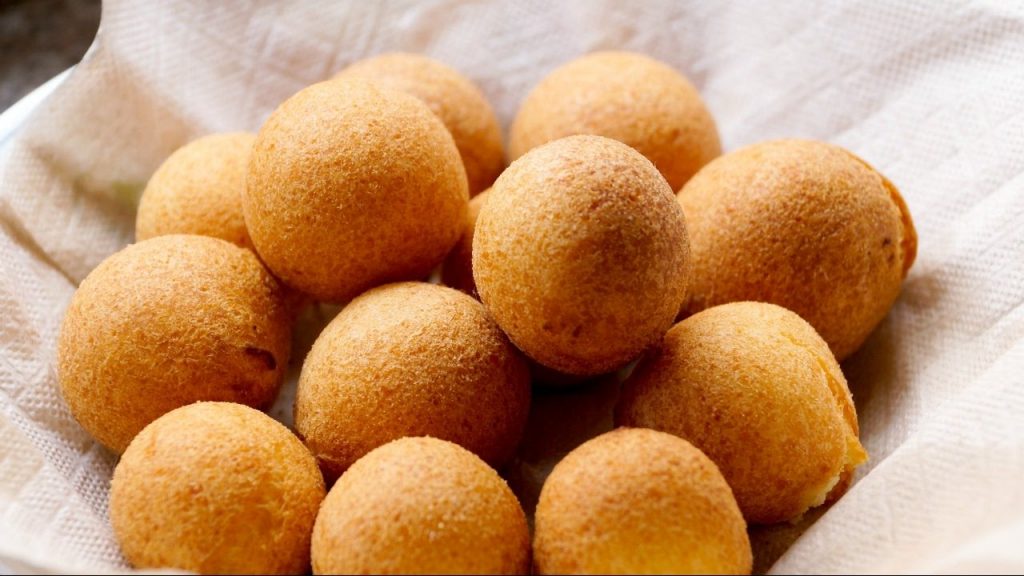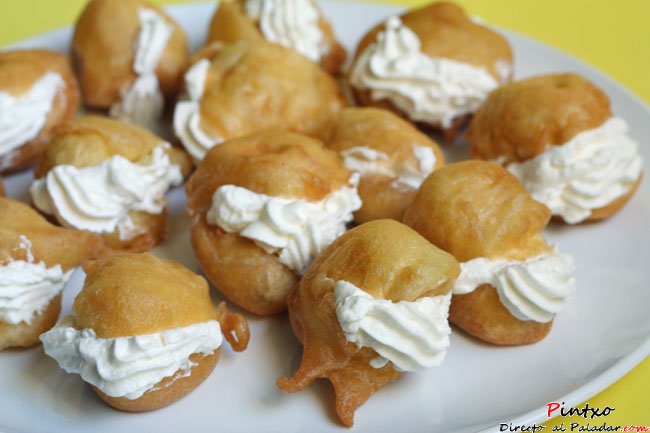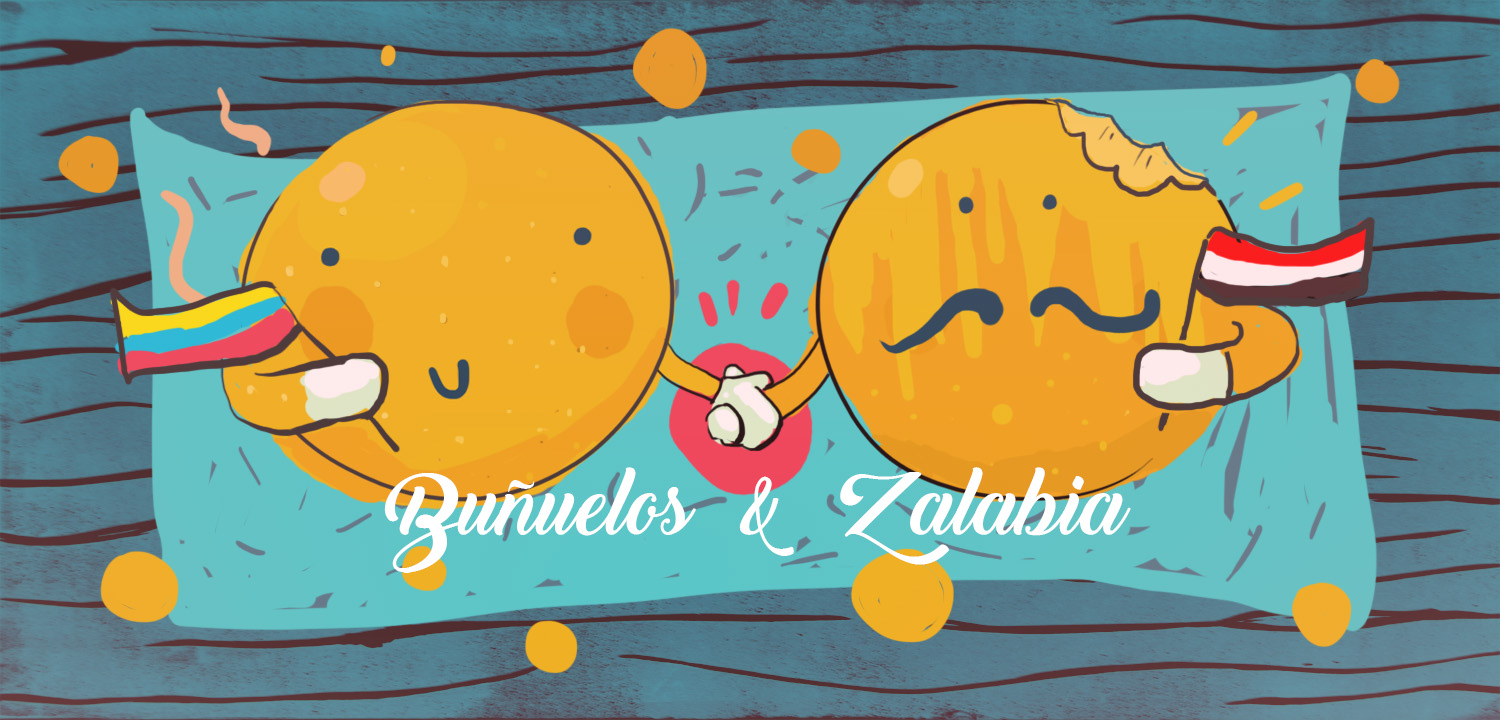When I first saw the frying pans filled with floating zalabia, the round shape was extraordinarily similar for me, even though I had never been to Egypt or the Middle East before. It’s oily, and sweet, and probably not healthy, but it´s delicious. The taste, however, was unexpected. I thought it would be slightly salty, because in my Southern-American home country, Colombia, we have something that looks exactly like zalabia, although larger and cheesy edging to the sweet, called “buñuelos”. We associate buñuelos with Christmas because it´s a tradition to eat them next to natilla (custard) during the traditional Novena de Aguinaldos, in which we visit each other’s house to read a booklet of prayers for nine days before Nativity (sometimes these visits become actual parties with people dancing and getting drunk).
I dismissed the similarity between buñuelos and zalabia until I found, by mere accident, that buñuelos were usually linked with Moriscos (Spanish Muslims forced to convert during the sixteenth century, and later expelled from Spain en masse during the early seventeenth).
It turns out that after the Catholic Kings took the kingdom of Granada in 1492, and after the terrible clashes of 1499 that we call now the first War of the Alpujarras, Muslims from Granada were forced to convert to Christianity or leave. In 1525 the order was made general, and all Muslims from the kingdom of Spain had to either convert to Catholicism or leave the country. Because their identity was seen by the Christians as possibly dangerous, and associated with disloyalty during the increasingly radical, fanatic, fascist Catholic Kingdom of Spain, Moriscos were denied permission to travel to America, even if proving being good Christians.
Charles V and later Philip II denied travel permits for the Moriscos, scared of having pagans or otherwise dissidents, confusing the indigenous people of America, which were to be converted to Catholicism, in an epic and “glorious” campaign of purification, invested by the pope and “god”, on the Spanish people.
Some Moriscos made it to America, nonetheless. Many went as slaves, many as wives of old Christians, others used all sorts of trickery to get fake permits, and others snuck in the ships that departed and threw themselves in the waters before docking in the ports of the Spanish controlled cities. The rumors of Moriscos and Muslims in the vast territories of colonial Latin America travelled fast and preoccupied the authorities. The Inquisition was established, looking to purge both crypto Jewish (Jews who had been forced to convert, also, but practiced Jewish religion in secret) and crypto Muslims (the same but about Muslims).
In 1611, in Santiago de Guatemala, a man named Nicolás de Oliva was accused of being a Morisco. During the trial the arguments against him included his skin color, his way of speaking and his profession. He was a Buñolero, a person who makes buñuelos, which was a profession usually taken by Moriscos in Spain. While other Moriscos were discovered by shouting “Allah” or “Mohamed” by accident before being taken to trial, Mr. Oliva’s crime was to make buñuelos. Some days after during the trial others accused Mr. Oliva of saying the name “Mohamed” once. Other witness said that he had seen Mr. Oliva in Seville, several years before, in the house of a Morisco, making buñuelos. Others noted that he was also circumcised and that he never carried a cross and seldom went to church.
The relation between Moriscos and buñueleros could have been strengthened because of a theater play by Lope de Vega (prominent Spanish writer from the “Siglo de Oro”), which had been widely disseminated at the time, but a census from 1589 in Seville confirms that the most popular job for a Morisco was to make buñuelos. Basically, food got intermixed with identity.[1] When the Moriscos were expelled, the gitanos (gypsies), continued the tradition.
After some research, I found that not only the buñuelos were highly consumed in Al-Andalus, but that they were prepared sweet, covered with boiling honey, as they are consumed today in Spain and other places in Latin America but not in Colombia). In fact, some of the recipes of zalabia and buñuelos are practically the same. The earliest mentions are from the 12th century, when a great corpus of culinary literature surged in al-Andalus. Recipes, medical dietary treatises and travel journals all share some information about the great richness of Andalusian cuisine. Buñuelos appear there by the name of Isfani, and there were many recipes including some with cheese, like the ones we eat in Colombia.[2] The master cook of Philip II, Francisco Martínez Montiño, described also a recipe for buñuelos in the 16th century.[3] But there were buñuelos made with eggplant, others with potatoes, later dipped in chocolate, filled with cream (buñuelos de viento), or even filled with fish! In Argentina the recipe is still the sweet one, bathed in hot syrup or honey, just like the zalabia, but sometimes they make them with chunks of apple. In Mexico the same buñuelos are made flat, like fried pancakes. In Nicaragua the buñuelos are surprisingly made with Yucca, mixed with cheese, although still served with hot honey or syrup.

So how did these fried golden spheres make their way to Egypt? Well, as you might expect, zalabia are everywhere in the Middle East, although, mostly reduced only to the original recipe with honey, and many times the same name refers to the spirals of dough, which seems to be coming rather from India. The round zalabia with honey is an Algerian passion during Ramadan. In Tunisia, a country that received thousands of Andalusi migrants expelled in 1609, zalabia has a special shape, and are called Mkharek. Just as regular round zalabia eaten elsewhere, Makharek are also a special sweet served during Ramadán.
It is hard to prove their Andalusi origin, and although they are pretty much everywhere in the east, the sources I have found link them to al-Andalus. In Europe, during the medieval period, any fried dough was already called a “Spanish fritter” and they can be considered a Mediterranean recipe because today similar fritters are also found in France and Italy.[4] Andalusians were constantly emigrating to the middle east, from as early as the 8th century. Al-Andalus has been considered a center of learning, highly developed and cultured, but this contrasts a lot with the number of scholars who left the so called “learned” Iberian Peninsula, looking for an education, escaping from prosecution, going for pilgrimage and making an obligatory stop in Egypt, or simple because of trade. Many of them returned, of course, but many stayed also. Scholar Gary Leiser[5] documented the importance of Andalusian Muslims in the formation of the educational sphere in late Fatimid and Ayyubid Egypt, showing an impressive number of them, staying in Cairo, Alexandria, and others going to Damascus and Aleppo. The famed traveler Ibn Jubayr described Andalusians living in Mecca, Damascus and Cairo in the times of Salah ad-Din. And after 1492, and later 1609, with the general expulsion, Moriscos were forced to leave Spain, and most went to Morocco, Tunisia and Algeria. It wouldn´t be unthinkable to imagine that some of the Andalusians that travelled abroad brought some culinary delicacies to Egypt. Some think that the name comes from an Andalusian traveler called Zerib, and that somehow the word derived into Zalabiya.[6]
But this story has one more ingredient. As you probably have heard, the Spanish Jews, or Sephardic Jews, were also expelled from Spain in 1492. Many Spanish Jews went to Turkey, others to Egypt, and some to the Maghreb. Ana Bensadón, a scholar in food history, compiled a list of recipes of the Sephardic Jews from many parts of the world, and the buñuelos are always included as they are considered a Sephardic Jewish food par excellence.[7] The encyclopedia of Jewish food states that although frying dough might be as old as the invention of pottery, already in the 13th century the Andalusian/Sephardic word bemuelo was being used. Rabi Jacom Culi, a Sephardic Jew in Istanbul wrote in his commentary to the Torah that the Manna (food sent by god during the 40-year biblical exodus) tasted like fried dough with honey and used the term bilmuelos. Slowly these golden balls dipped in honey or sprinkled with sugar became the primary food to celebrate Hanukah and Passover.[8] So that these buñuelos, bemuelos or zalabia have a religious meaning in the three better known monotheistic religions.
The real origin of these delicacies is still a matter of dispute, but at least we know that it was in al-Andalus that they were popularized. Now we should really consider how connected we have been for several centuries already. Our languages have much in common, some of our recipes and many of our attitudes towards everyday life are very similar, both in Latin America and the Middle East. We might not understand each other’s language, but at least our buñuelos/zalabia are culinary siblings. A delicious connection over centuries with curious variations across four continents. Now please go and get some zalabia, and while chewing on them remember you are also part of that history.

[1] Cook, Caroline, Forbidden Passages, 97-100; The play by Lope de Vega is Con su pan se lo coma, in which a Morisco romance is sung, mentioning Moriscos making Buñuelos.
[2] Sánchez, Expiración García. “La gastronomía andalusí.” VVAA. El zoco: vida económica y artes tradicionales en Al Andaluz y Marruecos. Barcelona: Lunwerg Editores (1995): 49-57.
[3] Montiño, Francisco Martínez. Arte de cocina, pastelería, vizcochería y conservería. en la imprenta de Pantaleon Aznar, a costa de la Real Compañia de Impresores, y Libreros del Reyno, 1778. 180
[4] Marks, Gil. Encyclopedia of Jewish food. Houghton Mifflin Harcourt, 2010.
[5] Leiser, Gary. “Muslims from al-Andalus in the’madrasas’ of late Fatimid and Aiyubid Egypt.” Al-Qantara 20.1 (1999): 137-159.
[6]http://andalushistory.com/%D8%A7%D9%84%D8%B2%D9%84%D8%A7%D8%A8%D9%8A%D8%A9%D8%8C-%D8%AD%D9%84%D9%88%D9%89-%D9%85%D8%B4%D8%B1%D9%82%D9%8A%D8%A9-%D8%A3%D9%86%D8%AF%D9%84%D8%B3%D9%8A%D9%91%D8%A9/
[7] Bensadón, Ana. Dulce lo vivas: la repostería sefardí, 2006.
[8] Marks, Gil. Encyclopedia of Jewish food. Houghton Mifflin Harcourt, 2010,







Comments (0)